Briefly: In our opinion, full (150% of the regular full position) speculative short positions in gold, silver and mining stocks are justified from the risk/reward perspective. This position was originally featured on Jan. 12, 2016 at 3:49PM.
The precious metals sector moved higher and we saw small breakouts in gold and mining stocks. What does it mean for the following days and weeks?
So far – not much. The breakouts were indeed small, which means that they are not confirmed. As such, they don’t change much, if anything. The same goes for the breakdown in the USD Index. Let’s take a closer look at the charts (courtesy of http://stockcharts.com).
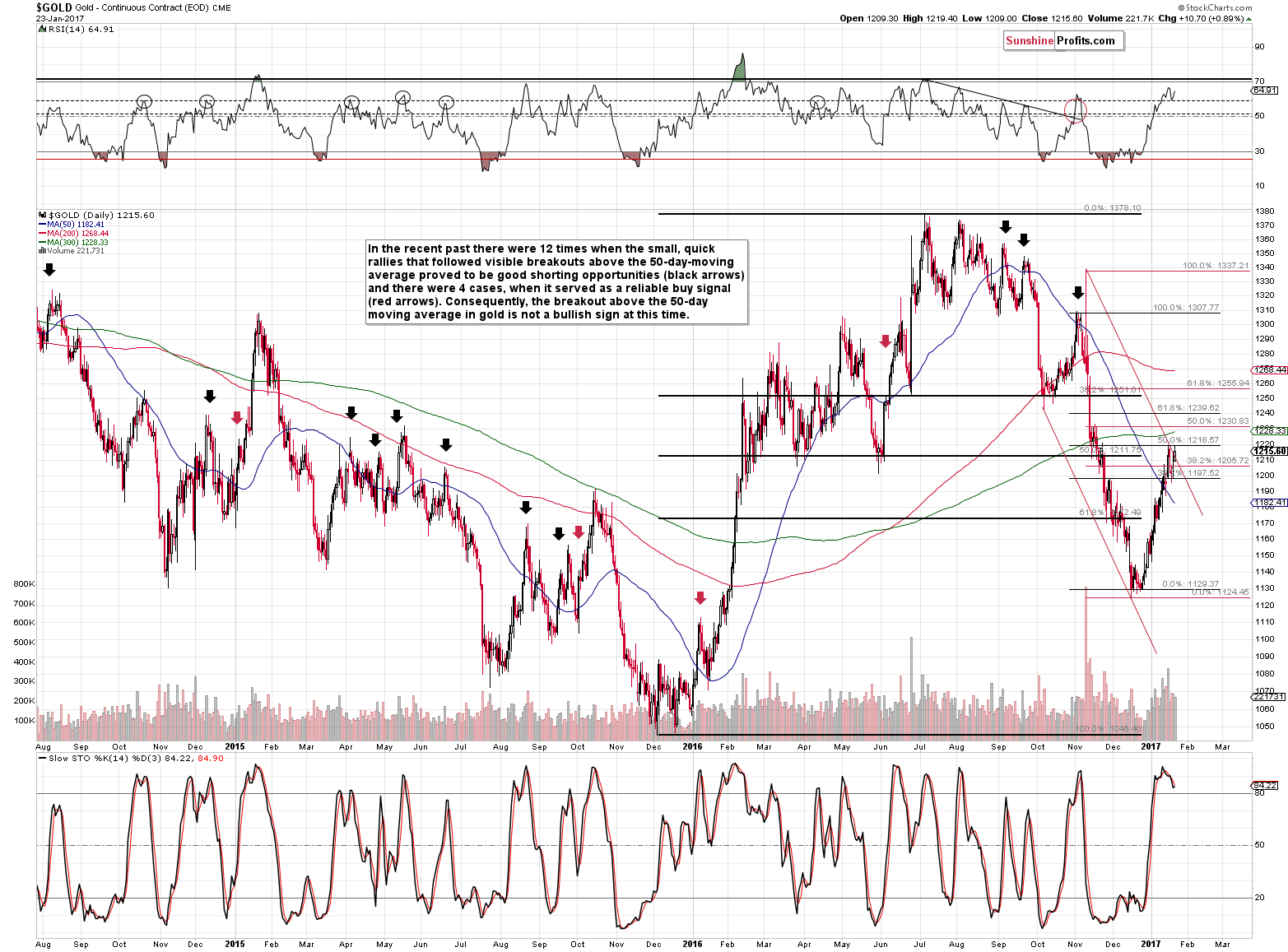
In yesterday’s alert, we wrote the following:
In the case of the short-term gold chart, we see that the declining red resistance line was once again touched, but not broken - the trend remains down. Gold once again closed the week below the 38.2% Fibonacci retracement based on the intra-day extremes (November – December 2016). Again, the downtrend remains in place.
The sell signal from the Stochastic indicator is now clearly visible, which makes the bearish case stronger.
The above signal still remains in place, but as far as the declining resistance line is concerned, we saw a small breakout. Small, because gold closed just a few dollars above it and the yellow metal declined once again in today’s pre-market trading. Consequently, the move has little implications, especially that it was not accompanied by huge volume.
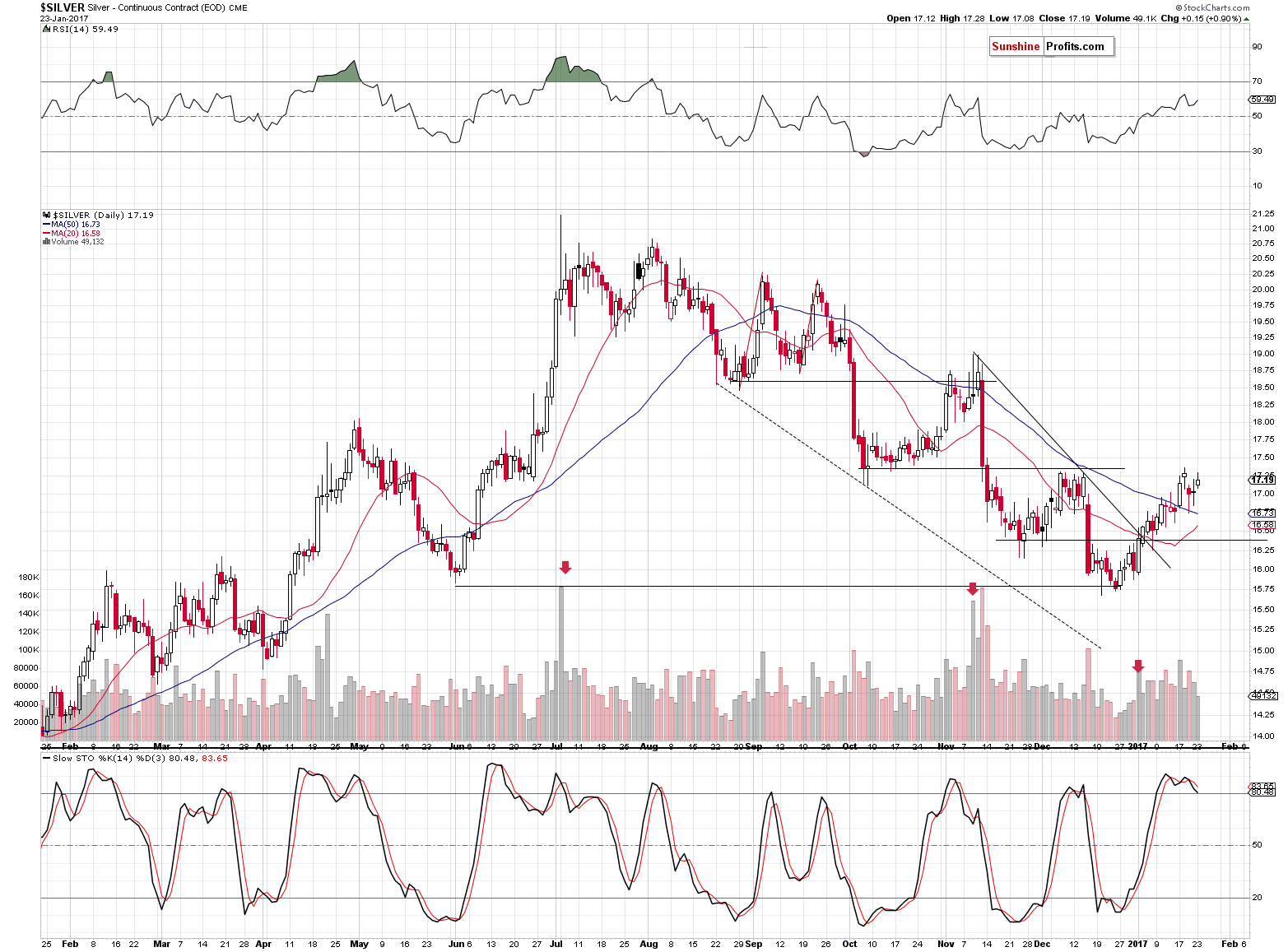
Silver’s move higher was also accompanied by relatively low volume, which doesn’t confirm the direction of the move. The sell signal from the Stochastic indicator also remains in place.

Another small breakout was seen in the case of the HUI Index. The 38.2% Fibonacci retracement level is at 208.27, while the HUI closed at 209.11 – less than one index point above the resistance. The breakout is indeed small and unless gold rallies today, it’s likely that miners will follow it and decline as well, thus invalidating the small breakout. All in all, it doesn’t appear that one should act on the small breakout just yet.
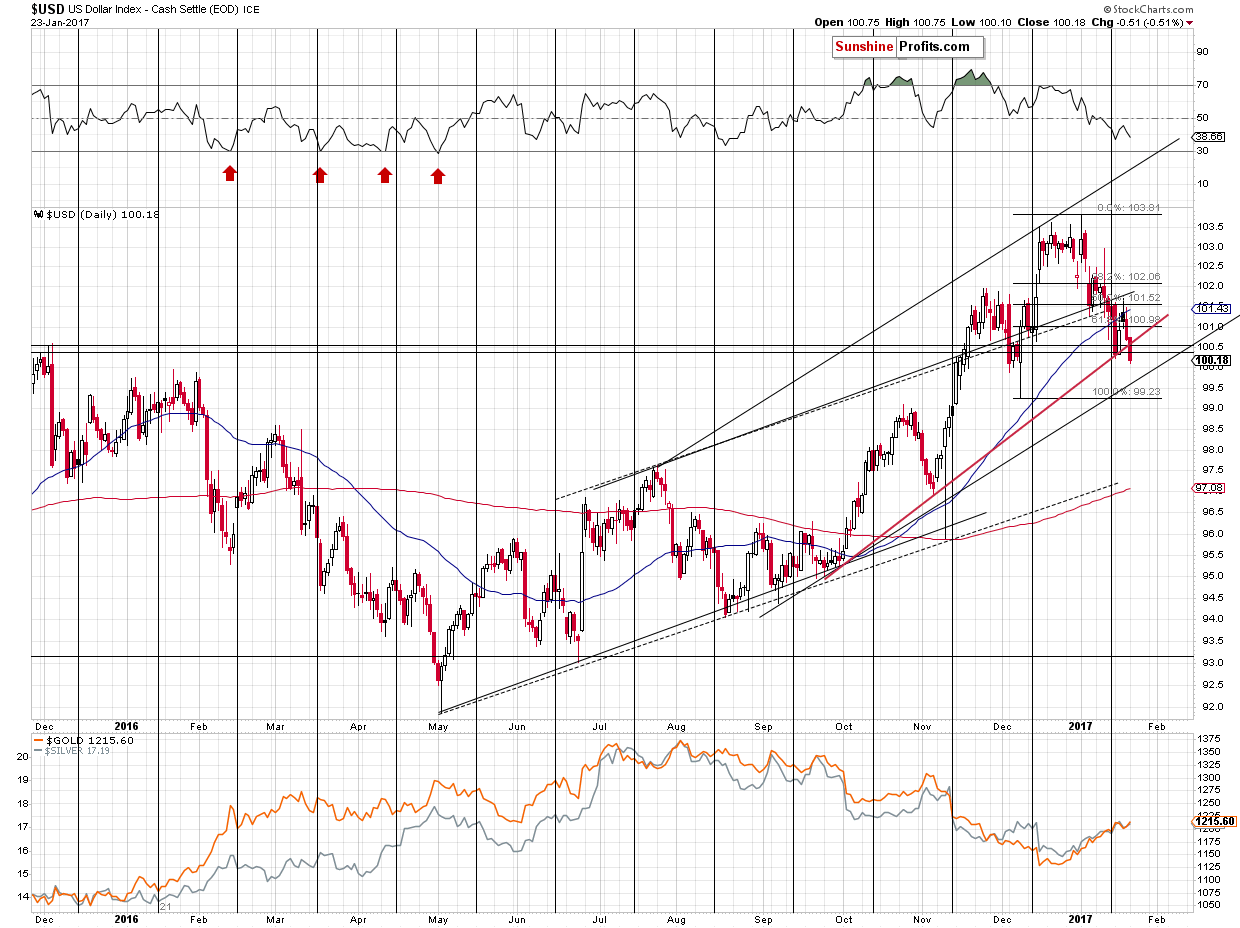
The USD Index broke below the rising red support line, but the size of the move was similar to breakouts in gold and the HUI – limited. The implications are also limited especially that the USD Index declined to 99.92 earlier today and moved back above yesterday’s highs, thus forming a reversal. Naturally, it’s too early to call it such, but if the session ended at the moment of writing these words (with the USD Index at 100.30), we would have a bullish reversal.
All in all, it doesn’t seem that yesterday’s session changed much, if anything. Before summarizing, we would like to discuss the issue of the current values of the Commitment of Traders report. We were asked to do so as neither large speculators, nor commercial traders seem to change their positions despite a price increase in gold in the past few weeks. In particular, the question was if this was a bullish action. As it is usually the case with the CoT report, the implications are rather unclear even though they appear to be clear at the first sight.
Since the net positions of both mentioned parties are not increasing, it seems as if the upswing has much more room to go (it is usually the case that positions become bigger along with gold’s price increases so the room for the positions to become bigger could be viewed as more room for gold to rally). However, previous similar cases don’t confirm the above.
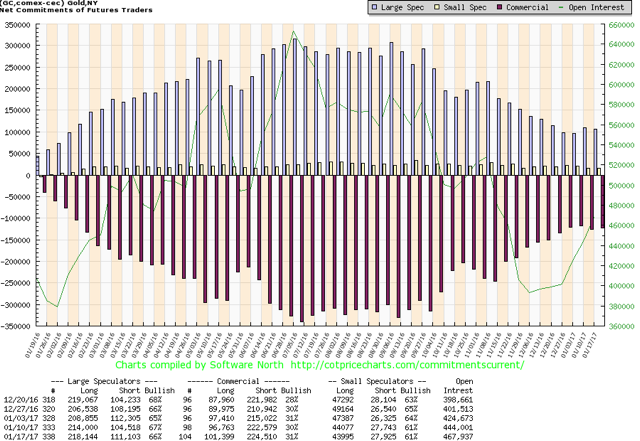
The above illustrates the positions in the past 12 months and the picture below illustrates the positions in 2013.
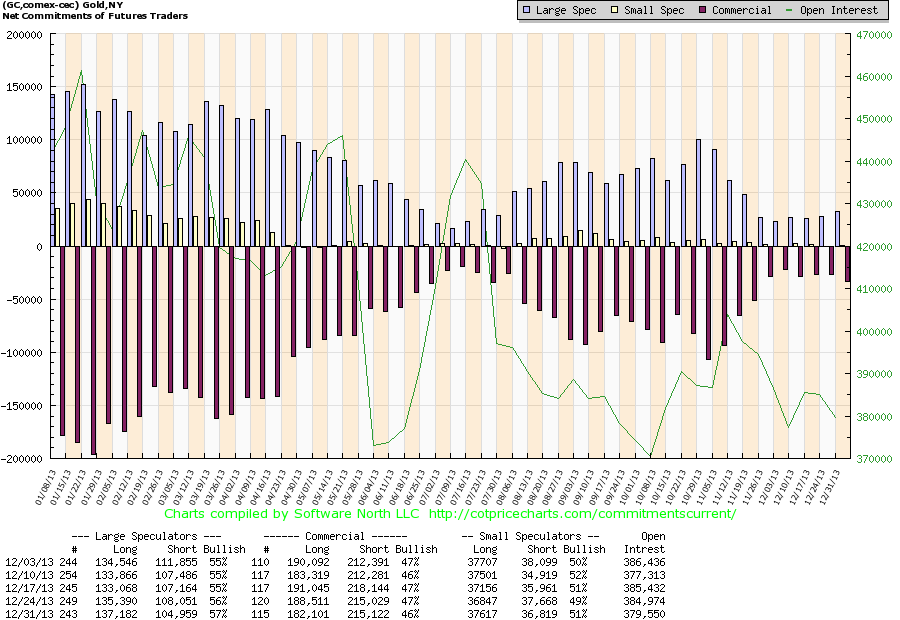
There was no visible increase in positions for 4 weeks mid-February 2013 to mid-March 2013.
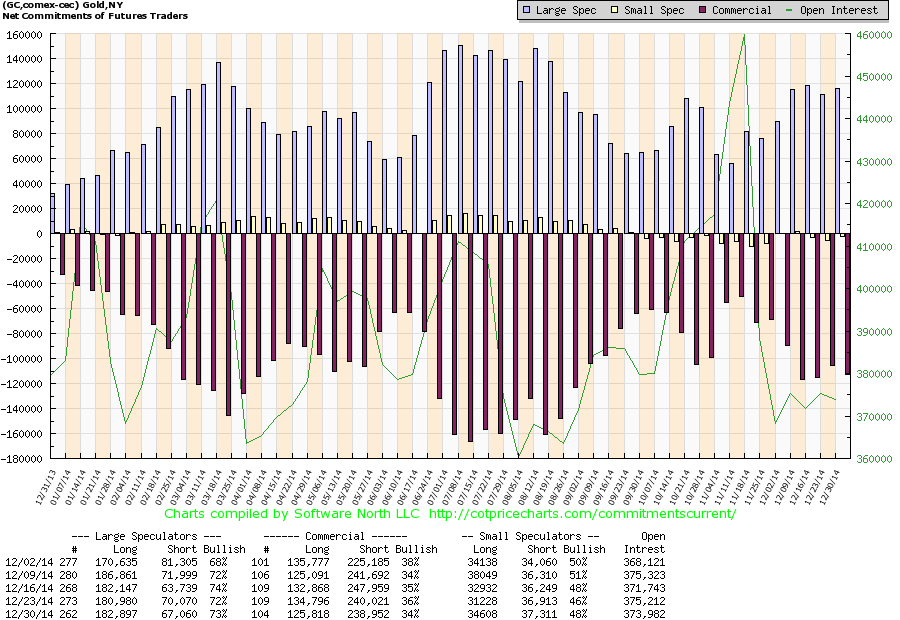
The above chart shows positions in 2014 and please note that there was no visible increase from mid-September 2014 to mid-October 2014.
What happened in both cases? Gold rallied from mid-February 2013 to mid-March 2013 and that was the final corrective upswing before the big plunge. The price increase from mid-September 2014 to mid-October 2014 was not as significant, but it was also followed by a sharp decline (over $100 slide). So, is the current stagnation in the sizes of positions in the CoT report really bullish? No.
Summing up, at this time it seems that yesterday’s rallies and small breakouts don’t have important bullish implications, as the they are very small and far from being confirmed. The implication of the current situation in the CoT reports doesn’t seem to change anything either. The short positions appear to be justified from the risk to reward point of view.
As always, we will keep you – our subscribers – informed.
To summarize:
Trading capital (supplementary part of the portfolio; our opinion): Short positions (150% of the full position) in gold, silver and mining stocks are justified from the risk/reward perspective with the following stop-loss orders and initial target price levels / profit-take orders:
- Gold: exit-profit-take level: $1,063; stop-loss: $1,243; initial target price for the DGLD ETN: $81.88; stop-loss for the DGLD ETN $48.78
- Silver: initial target price: $13.12; stop-loss: $17.53; initial target price for the DSLV ETN: $46.18; stop-loss for the DSLV ETN $22.86
- Mining stocks (price levels for the GDX ETF): initial target price: $9.34; stop-loss: $24.63; initial target price for the DUST ETF: $143.56; stop-loss for the DUST ETF $27.97
In case one wants to bet on junior mining stocks' prices (we do not suggest doing so – we think senior mining stocks are more predictable in the case of short-term trades – if one wants to do it anyway, we provide the details), here are the stop-loss details and initial target prices:
- GDXJ ETF: initial target price: $14.13; stop-loss: $40.12
- JDST ETF: initial target price: $104.26; stop-loss: $17.28
Long-term capital (core part of the portfolio; our opinion): No positions (in other words: cash)
Insurance capital (core part of the portfolio; our opinion): Full position
Please note that the in the trading section we describe the situation for the day that the alert is posted. In other words, it we are writing about a speculative position, it means that it is up-to-date on the day it was posted. We are also featuring the initial target prices, so that you can decide whether keeping a position on a given day is something that is in tune with your approach (some moves are too small for medium-term traders and some might appear too big for day-traders).
Plus, you might want to read why our stop-loss orders are usually relatively far from the current price.
Please note that a full position doesn’t mean using all of the capital for a given trade. You will find details on our thoughts on gold portfolio structuring in the Key Insights section on our website.
As a reminder – “initial target price” means exactly that – an “initial” one, it’s not a price level at which we suggest closing positions. If this becomes the case (like it did in the previous trade) we will refer to these levels as levels of exit orders (exactly as we’ve done previously). Stop-loss levels, however, are naturally not “initial”, but something that, in our opinion, might be entered as an order.
Since it is impossible to synchronize target prices and stop-loss levels for all the ETFs and ETNs with the main markets that we provide these levels for (gold, silver and mining stocks – the GDX ETF), the stop-loss levels and target prices for other ETNs and ETF (among other: UGLD, DGLD, USLV, DSLV, NUGT, DUST, JNUG, JDST) are provided as supplementary, and not as “final”. This means that if a stop-loss or a target level is reached for any of the “additional instruments” (DGLD for instance), but not for the “main instrument” (gold in this case), we will view positions in both gold and DGLD as still open and the stop-loss for DGLD would have to be moved lower. On the other hand, if gold moves to a stop-loss level but DGLD doesn’t, then we will view both positions (in gold and DGLD) as closed. In other words, since it’s not possible to be 100% certain that each related instrument moves to a given level when the underlying instrument does, we can’t provide levels that would be binding. The levels that we do provide are our best estimate of the levels that will correspond to the levels in the underlying assets, but it will be the underlying assets that one will need to focus on regarding the signs pointing to closing a given position or keeping it open. We might adjust the levels in the “additional instruments” without adjusting the levels in the “main instruments”, which will simply mean that we have improved our estimation of these levels, not that we changed our outlook on the markets. We are already working on a tool that would update these levels on a daily basis for the most popular ETFs, ETNs and individual mining stocks.
Our preferred ways to invest in and to trade gold along with the reasoning can be found in the how to buy gold section. Additionally, our preferred ETFs and ETNs can be found in our Gold & Silver ETF Ranking.
As always, we'll keep you - our subscribers - updated should our views on the market change. We will continue to send out Gold & Silver Trading Alerts on each trading day and we will send additional Alerts whenever appropriate.
The trading position presented above is the netted version of positions based on subjective signals (opinion) from your Editor, and the Tools and Indicators.
As a reminder, Gold & Silver Trading Alerts are posted before or on each trading day (we usually post them before the opening bell, but we don't promise doing that each day). If there's anything urgent, we will send you an additional small alert before posting the main one.
=====
Latest Free Trading Alerts:
Last week, Fed Chair Janet Yellen delivered a speech entitled “The Goals of Monetary Policy and How We Pursue Them” at the Commonwealth Club, San Francisco, California. What can we learn from it?
Yellen’s Speech in San Francisco and Gold
=====
Hand-picked precious-metals-related links:
Gold Demand in India May Only Return to Normal Levels in 2018
India’s gold market: evolution and innovation
Jim Armitage: London Metal Exchange’s members shot themselves in the foot
=====
In other news:
Dollar steadies after stumble, sterling rides out Brexit ruling
Pound Falls as Supreme Court Ruling Seen as No Brake on Brexit
Euro zone starts year with solid economic growth, but risks ahead
EU says will not sign off on Greece bailout review on Thursday
=====
Thank you.
Sincerely,
Przemyslaw Radomski, CFA
Founder, Editor-in-chief, Gold & Silver Fund Manager
Gold & Silver Trading Alerts
Forex Trading Alerts
Oil Investment Updates
Oil Trading Alerts



